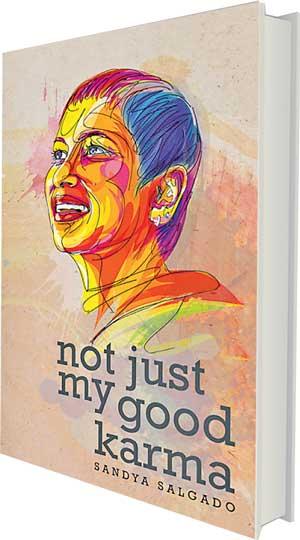Reply To:
Name - Reply Comment
Last Updated : 2024-04-20 20:10:00
Review of Sandya Salgado’s “Not Just My Good Karma”
 Sandya Salgado’s’Not Just My Good Karma’ is partly an autobiography and partly an account of a very different era in advertising in the country. Which of these I should be reviewing in this space, I don’t know. I haven’t met Sandya, I have only heard of her, but her prose affirms much of what others have said of her. Tempestuous, brash, frequently assertive, never really hostile, she has, to put it diplomatically, experience. If she says what she thinks and thinks what she says, it’s because she knows what she’s saying and has thought of what she’s going to do. And from 1983 to 2012, a full 30 years, that’s what guided her, in probably the most misinterpreted industry in this part of the world.
Sandya Salgado’s’Not Just My Good Karma’ is partly an autobiography and partly an account of a very different era in advertising in the country. Which of these I should be reviewing in this space, I don’t know. I haven’t met Sandya, I have only heard of her, but her prose affirms much of what others have said of her. Tempestuous, brash, frequently assertive, never really hostile, she has, to put it diplomatically, experience. If she says what she thinks and thinks what she says, it’s because she knows what she’s saying and has thought of what she’s going to do. And from 1983 to 2012, a full 30 years, that’s what guided her, in probably the most misinterpreted industry in this part of the world.
Before getting into her career, however, Sandya takes us through her home. It’s all there: her love for Panadura, her hometown (and in many ways mine); her memories of her mother, her father, her grandmother and grandfather; those uncles and aunties down her neighbourhood; those servants and householders and domestics who’d visit her house for no reason (“nikan awa”); and her friends, siblings, sons, and husband. It’s a rich canvas she opens up here: she even gets into, and then rejects, the caste-ism so rampant in her region; she cringes at it, but at the same time is frank, open, and honest about its existence.
It’s true that, as she says, when you cross the Digarolla Bridge in Moratuwa (which she had to when she was moved to Musaeus College after spending five years at her mother’s school, Sri Sumangala), you enter not just a new district but a whole new world. This doesn’t turn out to be an excuse to move there later on, though; Sandya begins her anecdotes by refuting those who think she will or ever did entertain such a thought. In a way, it’s this interplay between Panadura and Colombo, between adolescence and adulthood, between Sinhala and English, between family and career, between the love for a way of life that’s fast disappearing and the desire to move on, which she tries to resolve. As such, mercifully, even when she gets into her career, she doesn’t try to intellectualise. It’s all there, in flesh and in blood.
 Coincidentally or calculatedly, Sandya entered advertising when the field had begun to pick up after 20 years of sterility. As Steven Kemper, in his unacknowledged masterpiece that is his study Buying and Believing, has pointed out, advertising until 1978 was uneconomic in character, though as Sandya herself points out this did not prevent many of the stalwarts in the industry, like Anandatissa de Alwis, from coming up with stellar campaigns. Neil Wijeratne, who shone at a leading advertisement firm in the 70s, told me of another campaign for Batteries, and was penned by Cyril C. Perera. (Sandya, however, after much research, concludes at the tail end of her book that the name of the writer remains unknown).
Coincidentally or calculatedly, Sandya entered advertising when the field had begun to pick up after 20 years of sterility. As Steven Kemper, in his unacknowledged masterpiece that is his study Buying and Believing, has pointed out, advertising until 1978 was uneconomic in character, though as Sandya herself points out this did not prevent many of the stalwarts in the industry, like Anandatissa de Alwis, from coming up with stellar campaigns. Neil Wijeratne, who shone at a leading advertisement firm in the 70s, told me of another campaign for Batteries, and was penned by Cyril C. Perera. (Sandya, however, after much research, concludes at the tail end of her book that the name of the writer remains unknown).
The JR Jayewardene regime opened up the economy, and while it let in a flood of import led consumption patterns which haven’t receded even now, it gave much needed breathing space for advertisers; right until the 90s, Kemper tells us, the industry grew at a dizzying 20% a year. The change didn’t have to do with numbers only though: the focus itself shifted, from keeping up reputations to actually building brands and sleekly, subtly, but discernibly differentiating them from the competition. It is against this backdrop that Sandya applied for a job, armed with a degree from Kelaniya, in 1983. Over the next 30 years, she’d work for four big advertising names.
(I know of social scientists, cultural critics, and commentators who bemoan this lowering of standards, and I know many of them fault advertising for it. But here’s the paradox which has come to enrich advertising: for nearly 50 years, after they broke away from the Civil Service, which had by then deteriorated, many of our artists survived through the ad industry.
If Lester James Peries earned the same amount from a TVC for a video recorder that he did from directing an entire film – Rs. 40,000 – what more can be said?).
Soon after entering TAL, Sandya got to handle, among other commercial brands. From these she quickly moved on to other brands: banking, milk, confectioneries, fashion, and washing powder (which, sources tell us, received the highest amounts of advertising expenditures in the 80s and 90s). To dig into every one of them here is not my purpose; suffice it to say that what caught my attention the most were the public service campaigns (labelled incorrectly, as she admits, as “social marketing”): the measles, polio, and leprosy eradication, child abuse, and iodised salt campaigns. These were all done at nominal rates: Neela Wickramasinghe, a polio patient herself, appeared in the now famous polio ad free of charge. Sandya’s admits that the idea to have Neela was at first opposed; it was so novel, unprecedented, and unheard of, though, that in the end, not only was the campaign successful, but it also went to win the Max Lewis Memorial Award at the 15th Asian Advertising Congress in Bangkok.
Sandya moves away from advertising towards the end. Having retired from another advertising firm, (though not from advertising: it’s easier to think of a leopard changing her spots), she finds herself at the World Bank (where she runs into walls, tries to fight through them, and in a catharsis of despair and disillusionment, moves on), channels her passion for local cinema through Film Island and tourism through Jungle Fowl, and establishes her own Good Karma Consultancy. Along the way, she does her bit for her political beliefs (which, to be frank, are not mine) by conceiving probably the most unlikely but creative campaigns for one of the few politicians she looks up to, Harsha de Silva. It’s only fitting that she ends at the “latest development” at the time of the book’s publication: the Easter attacks. Between 1983, when we witnessed the worst ever pogrom against Tamils, and 2019, when we witnessed an upsurge of hate against Christians and Muslims, Sandya thus sees much to be upset, and also hopeful, about.
Given how the economy has gone down, and is going down, it’s not really surprising that advertising has become tamer and more conservative; more fearful, in fact. This contention I am not willing to fight over or fight for, but experience bears me out. In any case, as a friend of mine put it, creativity survives and supersedes profits and economics. If Sandya’s account of her career is anything to go by, we have many a stalwart, pioneer, and giant from the field to thank for, icons she herself associated with: from the “father” Reggie Candappa to the still-there-and-very-much-active “grandson” Irvin Weerackody; it is up to us, “creatives” working in the field, to take forward and add to what they pioneered.
Sandya Salgado spent 30 years in advertising. So far, I’ve spent three. I am still a student. Through her book, she taught me well. To put that succinctly, this is a memoir of a life in the industry I was waiting to devour. That I enjoyed it thoroughly is beside the point. The point, as always for a review, is that you should buy and thumb through it.

Add comment
Comments will be edited (grammar, spelling and slang) and authorized at the discretion of Daily Mirror online. The website also has the right not to publish selected comments.
Reply To:
Name - Reply Comment
On March 26, a couple arriving from Thailand was arrested with 88 live animal
According to villagers from Naula-Moragolla out of 105 families 80 can afford
Is the situation in Sri Lanka so grim that locals harbour hope that they coul
A recent post on social media revealed that three purple-faced langurs near t